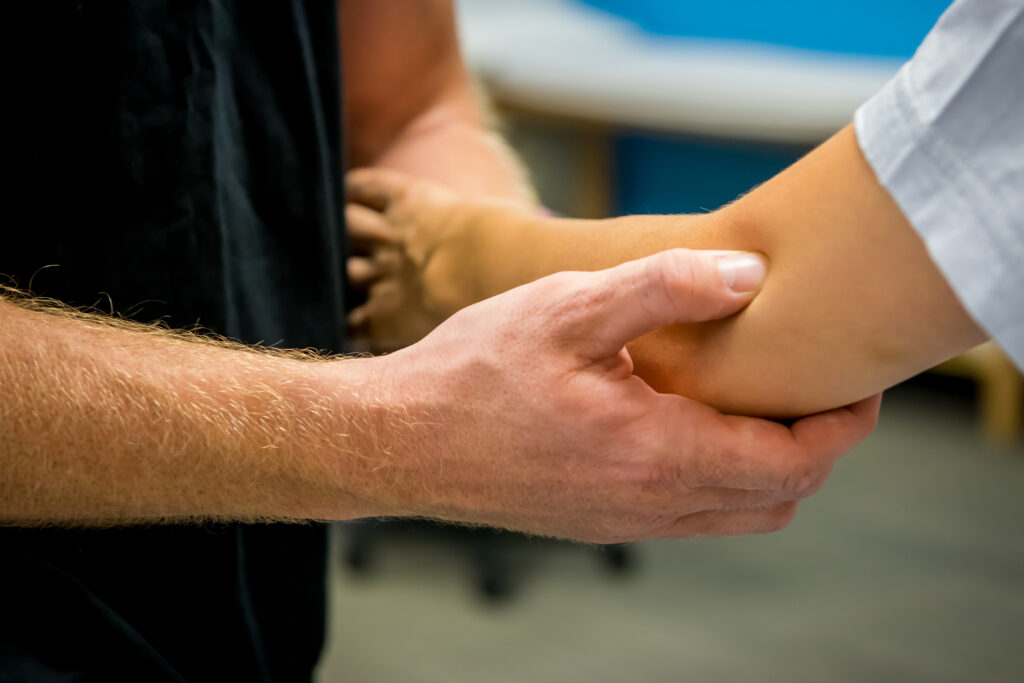Tennis elbow is a condition that can cause considerable pain and discomfort. However, with the right treatment plan, it’s possible to manage the symptoms and prevent further complications.
We take you through the causes, symptoms, diagnosis and treatment of this common condition. Find out how physiotherapy can help you recover from tennis elbow.
What is Tennis Elbow?
Tennis elbow, medically known as lateral epicondylitis, is a condition that affects millions of people globally. Tennis elbow symptoms include pain and tenderness on the outer side of the elbow, which often makes it difficult to perform basic tasks such as gripping objects or lifting things
If you’re experiencing any symptoms of tennis elbow, it’s essential to seek appropriate treatment as soon as possible to prevent any further complications from arising.
Symptoms and Causes of Tennis Elbow
Lateral epicondylitis is due to repetitive strain on the tendons in the elbow joint. This repetitive strain can come from various activities such as playing tennis, typing at a computer or even doing manual labour. Tennis elbow symptoms include pain and stiffness in the elbow joint, weakness in the forearm and difficulty gripping objects.
If you’re experiencing these symptoms, it’s important to see a professional promptly for a proper diagnosis and treatment plan. Treatment options may include rest, ice, compression and physiotherapy. In severe cases, surgery may be necessary. With proper care and treatment, most people with tennis elbow can recover fully and return to their normal activities.
Diagnosis of Tennis Elbow
Tennis elbow is diagnosed by a doctor or a Physiotherapist through a physical exam that checks for pain and tenderness. Imaging tests may be ordered.
Patients can see a physiotherapist who will create a personalised treatment plan to help manage symptoms. Exercises to stretch and strengthen the forearm muscles and tendons are recommended, along with rest, ice and compression. Modalities such as Dry Needling and soft tissue releases may help in unloading some of the surrounding tissues. The most important exercise focus begins with an isometric loading program to help the tendon insertion become conditioned to tolerating loads. Braces or splints may be needed in severe cases. Early diagnosis and treatment can help patients manage symptoms and recover fully.
Physiotherapy Treatment for Tennis Elbow
If you’re suffering from tennis elbow, physiotherapy might be your first line of defence. Your physiotherapist may recommend some treatments, such as exercises to strengthen your forearm muscles, joint mobilisation and massage therapy. These techniques can help alleviate pain and reduce inflammation in your elbow. Additionally, you may be advised to use a brace or splint to support your elbow joint during physical activity. With the help of a skilled physiotherapist, you can work towards reducing your symptoms and getting back to your daily routine.
Tennis elbow can be a debilitating condition that affects the tendons and muscles in the forearm. However, with the right exercises, you can help strengthen these muscles and tendons, thereby reducing the likelihood of further injury.
Some activities that may be recommended for tennis elbow include wrist curls, reverse wrist curls and forearm twists. Reformer Pilates can also go a long way in helping you heal by addressing postural re-balancing and shoulder blade stability, provided that you are able to handle the gripping required. A qualified physiotherapist can guide you on the proper technique and ensure you don’t exacerbate your lateral epicondylitis.
By working with a professional and pinpointing the appropriate exercise and therapy regime, such as manual therapy, you can help alleviate the pain and discomfort associated with tennis elbow and get back to your usual activities.
Prevention of Tennis Elbow
Tennis elbow is a condition that can be both painful and frustrating, and preventing it involves taking certain precautions. One of the most important steps is to avoid repetitive activities that can put undue strain on the elbow joint. This might include taking frequent breaks during activities like typing or playing sports, using proper technique to reduce the impact on your elbow, and wearing protective gear, such as elbow pads or braces.
By incorporating these measures into your daily routine, you can help prevent tennis elbow and keep your arms and elbows healthy and pain-free.
Lifestyle Changes for Recovery
If you’re suffering from tennis elbow, physiotherapy treatment could be helpful. But it’s important to remember that other factors can also contribute to the recovery process. Making specific lifestyle changes, like modifying your daily routine to avoid activities that aggravate the condition, getting enough rest, and eating a healthy diet, can all play a significant role in your recovery. Taking a holistic approach to treatment may increase your chances of healing and getting back to your regular activities sooner.
Need physiotherapy treatment for tennis elbow? Book now at MGS Physiotherapy and start your journey to recovery today.
CALL NOW TO BOOK YOUR APPOINTMENT

